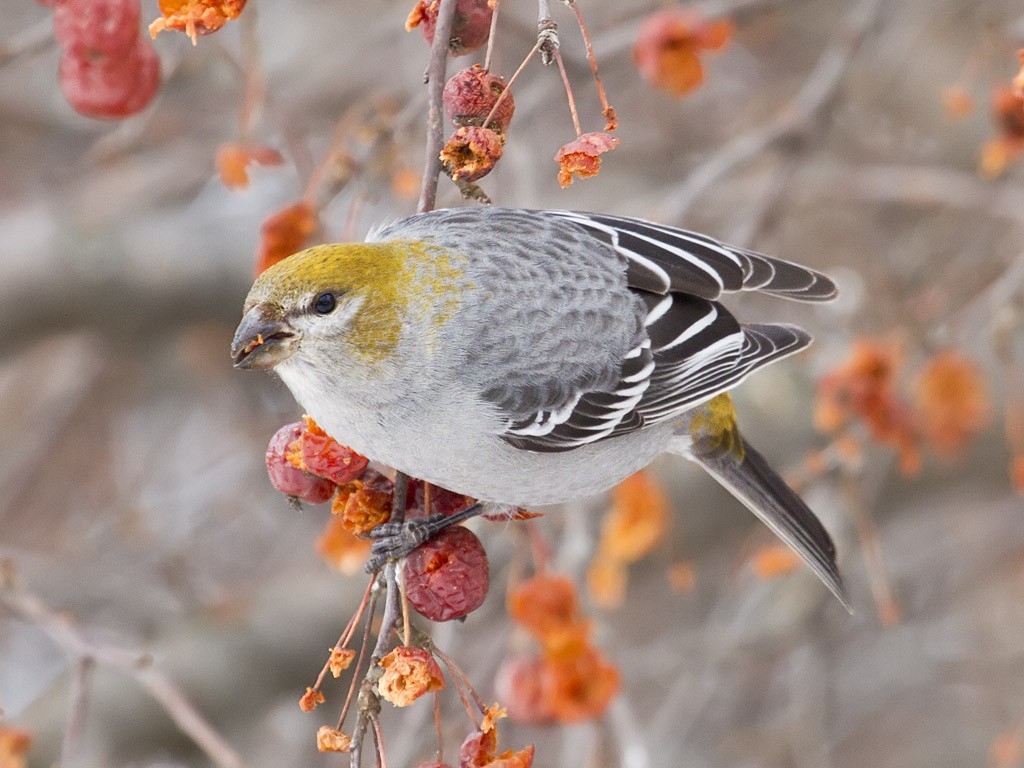Pine Grosbeak
A species of Pine Grosbeaks Scientific name : Pinicola enucleator Genus : Pine Grosbeaks
Pine Grosbeak, A species of Pine Grosbeaks
Botanical name: Pinicola enucleator
Genus: Pine Grosbeaks
Content
Description People often ask General Info
 Photo By Bill Bouton , used under CC-BY-SA-2.0 /Cropped and compressed from original
Photo By Bill Bouton , used under CC-BY-SA-2.0 /Cropped and compressed from original Description
This species is one of the largest species in the true finch family. It measures from 20 to 25.5 cm (7.9 to 10.0 in) in length and weighs from 52 to 78 g (1.8 to 2.8 oz), with an average mass of 56.4 g (1.99 oz). The pine grosbeak's wingspan is 13.0 in (33 cm). Among standard measurements, the wing chord is 10.2 to 11.6 cm (4.0 to 4.6 in), the tail is 7.8 to 9.5 cm (3.1 to 3.7 in), the bill is 1.4 to 1.65 cm (0.55 to 0.65 in) and the tarsus is 1.9 to 2.3 cm (0.75 to 0.91 in). Adults have a long forked black tail, black wings with white wing bars and a large bill. Adult males have a rose-red head, back and rump. Adult females are olive-yellow on the head and rump and grey on the back and underparts. Young birds have a less contrasting plumage overall, appearing shaggy when they moult their colored head plumage. Its voice is geographically variable, and includes a whistled pui pui pui or chii-vli. The song is a short musical warble. 
Size
20 - 26 cm
Colors
Brown
Black
Yellow
Red
Gray
Life Expectancy
9.5 years
Nest Placement
Tree
Clutch Size
3 - 4 eggs
Number of Broods
13 - 14 days
Nestling Period
13 - 20 days
Feeding Habits
Pine Grosbeak's diet predominantly consists of seeds, buds, and fruits from various trees such as spruce and pine, as well as plants including maple and blackberry. They forage in trees and on the ground, and their winter diet may include road grit and salt. During summer, pine Grosbeak supplements its diet with insects and spiders, notably for chick rearing. They readily frequent feeders offering sunflower seeds or suet and hydrate with water or snow.
Habitat
Pine Grosbeak are typically found in northern boreal forests, primarily comprising spruce, pine, and fir trees. They favor open evergreen forests across Canada, mountainous regions in the Western United States, and subalpine forests in Eurasia. Preferentially, they reside at altitudes above 6,000 feet in areas like the Sierra Nevada and near or above the timberline at 9,000 feet in the Rocky Mountains. During winter, they may stay within similar habitats, descend to lower elevations, or relocate to places rich in fruiting trees like mountain ash, maple, and ash.
Nest Behavior
Pine Grosbeak females construct the nest, timing nest building with spring or early summer. Egg-laying follows the construction, with specific patterns varying geographically. Both parents partake in parental care, safeguarding eggs and nurturing the young.
Nest Characteristics
Pine Grosbeak's nest is often found in evergreen trees, concealed by vegetation near the trunk, 6-16 feet up. The loose foundation of evergreen twigs supports an inner cup woven from roots, smaller twigs, and grass, lined with lichen, needles, soft grasses, and feathers. The nest measures 6–9 inches wide and 3–4 inches deep, with a cup approximately 2.5–3 inches across.
Dite type
Granivorous
People often ask
General Info
Feeding Habits
Bird food type

Black Oil Sunflower Seeds

Hulled Sunflower Seeds

Suet

Fruit
Bird Feeder Type

Large Tube Feeder

Large Hopper

Platform
Sounds
Song
Recording location: Japan
Call
Recording location: United States
Behavior
Pine Grosbeak exhibit a leisurely demeanor, often seen hopping in trees, gleaning young shoots or picking seeds and fruits. On the ground, they forage for dropped seeds or fruits. Seasonal seed production influences their survival and breeding success, prompting irruptions beyond their typical range in search of sustenance. During winter, pine Grosbeak forage in cohesive groups of 5–15, showing fidelity to specific call types within these assemblies. Breeding season witnesses monogamous pair formation, males serenading from high perches to assert territory, with mated pairs sharing unique flight calls, suggesting a deep pair bond.
Distribution Area
Pine grosbeaks breed in the boreal forests of northern Eurasia and North America, and typically either remain resident near their breeding grounds or migrate relatively short distances to the southern extent of boreal forests. During irruptive years, more travel to southern boreal forests and some move further south. In such years in the New World, they can occur well south of their typical winter distribution, which is the northern Great Lakes region and northern New England in the United States. This species is a very rare vagrant to temperate parts of Europe; in all of Germany, for example, not more than 4 individuals per year and often none at all have been recorded since 1980. 
Scientific Classification
Phylum
Chordates Class
Birds Order
Perching birds Family
Finches Genus
Pine Grosbeaks Species
Pine Grosbeak